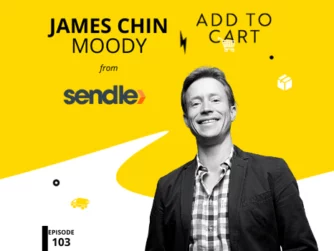When it comes to marketplaces, few know the space better than Sean Walsh, Director at Pattern Australia. With roots in Practicology and experience across hundreds of retail and DTC strategies, Sean now leads one of the world’s largest (yet often invisible) marketplace operators. Pattern isn’t just a marketplace agency. They’re a retail force, running end-to-end ecommerce operations for brands like Thankyou and managing over 39 trillion data points across Amazon, Walmart, and beyond.
They’re Amazon’s biggest seller outside of Amazon itself, backed by proprietary tools like Pattern PXM, an AI-powered content engine that boosts conversions, and Shelf, their newly launched supply chain technology that gives brands real-time inventory visibility across marketplaces. In this episode of Add to Cart, Sean breaks down how to approach marketplaces strategically, not just tactically, and why your Amazon performance is often just a reflection of your overall distribution health. He also takes us through Pattern’s recently released 2025 Marketplace Consumer Report – a must read for anyone in ecommerce!
Distribution Isn’t Just a Sales Strategy. It’s a Marketplace Weapon
Success on marketplaces doesn’t start with marketing, it starts with distribution. And according to Sean Walsh, “Amazon is a mirror of your distribution.” That means if your products are turning up cheaper elsewhere—whether through rogue resellers, discount-heavy retailers or international grey market listings, Amazon will notice and take action.
Amazon’s algorithm is designed to protect customer experience above all else. If Amazon spots your product listed significantly cheaper elsewhere, say $10, $20, or even $30 less, it flags it as a poor customer experience and the result is what’s known as buy box suppression. When the buy box is suppressed, the usual ‘Buy Now’ button disappears, and sales plummet. This is why brands need to clean up their distribution channels before diving into marketplaces. Sean advises a simple starting point:
Run your own Google Shopping search and see how many price points come up. If there’s more than three, it’s time to clean house.
But even with strong distribution, the model you choose matters. Brands need to weigh up whether to go down the 1P path (selling directly to Amazon), 3P (selling on Amazon), or work with an accelerator like Pattern. Each has trade-offs.
“If you’re a retailer, you’re already buying at a wholesale price and you’re trying to sell it on Amazon where they’re taking 25% as well. That makes it extremely difficult.”
Pattern’s model, where they buy stock wholesale and manage the marketplace presence end-to-end, offers a blend of strategic control, operational scale and data transparency that many brands find appealing.
Evergreen Beats Hype. Every Time.
Many ecommerce brands are built around seasonal drops, hype cycles and product launches that grab attention, especially in the DTC space. But marketplaces like Amazon don’t work that way. Algorithms don’t reward hype. They reward history, consistency and reliability. That’s why evergreen SKUs are the secret weapon for growth on Amazon.
If you’re doing seasonal drops and it goes out of stock and you never sell it again, that’s not going to really work on marketplaces. You have to build authority.
Unlike DTC, where you control the homepage and can push whatever product you want into the spotlight, Amazon relies on customer behaviour and long-term product performance. Visibility isn’t something you can pay for once—it’s something you earn and defend over time. Each product earns its place through search relevance, conversion rate, customer reviews and fulfilment consistency.
If you’re constantly switching SKUs or dropping out of stock, you’re resetting that momentum every time. That means if you’re trying to make a splash with a one-off range, or you’re frequently out of stock, marketplaces may not be the best fit.
“You’re building the flywheel. Six, 12 months after you’ve ramped, it’s always on and you own the category. And it never goes away…They’re the categories that products will win—versus those that are seasonal or limited drops, which are there and then gone because you haven’t fed the flywheel.”
For brands considering a marketplace strategy, the best place to start isn’t your trendiest new launch, but your top three core products. If you can keep them in stock, maintain strong margins, and steadily build reviews. Do that well, and the flywheel will take care of the rest.
Don’t Underestimate Content and Search
People forget that Amazon is a search engine—and to win, you need to treat it like one. That means optimising every word and image, understanding how people are searching, and investing in ranking, not just visibility. In this environment, your ability to rank in the top four organic results for your key search terms is critical. That top row is the digital equivalent of eye-level shelf space in a supermarket, and it’s worth fighting for.
Amazon is less a store and more a search engine. “Shoppers don’t browse—they search, compare, and buy…70% of the search page is paid activity… but ranking in the top four organic spots is where 80% of the organic clicks go.
Pattern uses a powerful combination of tech and data to do exactly that, tracking share of voice and shelf for every keyword across every category.
“We have one of, if not the most, data points on marketplaces in the world. “The last count was around 39 trillion. So that’s a lot of zeros.”
But even without Pattern’s tech stack, brands can take practical steps: start by identifying your top ten keywords, assess where you’re showing up, and compare your listings to top competitors. It’s not just about keywords either. Creative matters.
“There’s foundational things from a content perspective. Retail readiness, which is how many images do you have? What’s your title look like? What’s your bullet points look like? What’s your A+ content look like?”
And when the creative meets the data, magic happens. “Amazon recently said to our CEO in the US, ‘What are you guys doing? You’re growing brands twice as fast as we are.’”
Marketplaces Reward Mastery, Not Presence
Winning on marketplaces isn’t just about showing up, it’s about showing up well. Success on platforms like Amazon is the outcome of disciplined distribution, strategic product selection, and relentless focus on content and search performance. It’s not a place for shortcuts or last-minute launches. It’s a channel that rewards brands who think long-term, play the algorithm wisely, and invest in building trust with customers over time. If you treat marketplaces like an afterthought, they’ll treat your brand the same way. But if you’re ready to play strategically, the compounding returns can be game-changing.
Curious why seasonal drops flop, how 39 trillion data points fuel growth, and what Amazon really thinks of your pricing? Listen to the full episode here.






